I admit it. I can’t keep up … I’m not as industrious as most of my gardening friends are when it comes to the effort necessary to manage my 6 acre landscape.
It can get overwhelming, especially when there are previous beds that came with the property that had been neglected for 10 years or more by the elderly lady who owned the property before us, and where perennial weeds are well established.
I make a valiant effort in the Spring, with all the enthusiasm of the new season to clean them up … dig the perennial weeds … plant something new (usually a division, or a naturally layered specimen, from elsewhere, or one shared from friends), but by mid-July or so, I have to redirect my efforts to the places that I’ve created … the shade garden … the rock (mostly sedum) garden … mulching the new trees and shrubs, and of course my tomatoes, so these previous places don’t get the attention they deserve.
But then again, some surprisingly beautiful, and beneficial results can happen in spite of (because of?) the neglect …
This is a “pre-me” bed of mostly Japanese Anemone stretching between two arbors, with Trumpet Vine (Campsis radicans) (pre-existing), and Climbing Hydrangeas (Hydrangea anomala) (me added), anchoring each end.
The Goldenrod (Solidago) and White Snakeroot (Ageratina altissima I think) now dominate, along with Sweet Autumn Clematis (C. terniflora), a non-native introduction that appears on watch lists as an invasive species in our area.
Yet look at the insect life. Scads of hoverflies (some species of Syrphid), who in addition to their role as pollinators as adults, are voracious consumers of aphids in their larval stage.
Scoliid wasp, predatory on Japanese Beetles.
An Ailanthus Webworm Moth (Atteva aurea), which uses the invasive Tree of Heaven (Ailanthus altissima) as its larval source for food.
And my, and most folks favorite these days, honeybees (Apis mellifera)
And if I kept up the weeding of this neglected bed, would there be a self-seeded Hydrangea paniculata available to transplant elsewhere?
So, probably a rationalization to justify my laziness … but looking on the bright side, there can be beneficial results from my neglect.
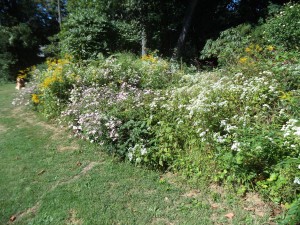
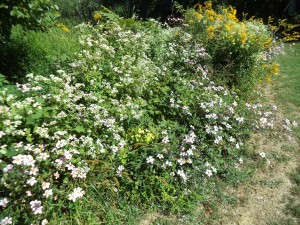
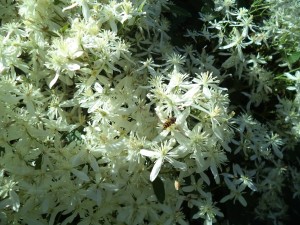

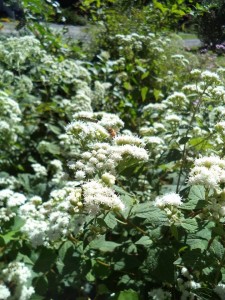
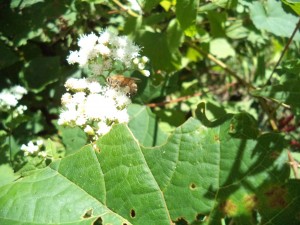
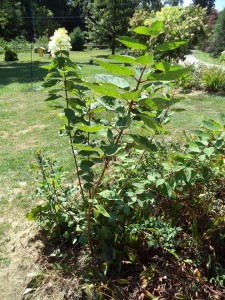
Great post! I totally agree about the properties with neglected old ‘gardens’. It’s the same each time for me too – I’m enthusiastic, clean the garden, dig where needed, plant what I’ve decided, rearrange the garden and there comes the moment when all the enthusiasm has gone away and I just forget about my garden chores. Most of the time I pay attention to the perennials (bushes and trees)in the garden in fact. Greets!
Glad you liked it … I thought there might be others out there with the same, or similar outlook.
Cheers!
So glad to see this post, b/c I’ve been down on myself for not attending to (“the side yard of everything invasive/weedy exisiting in North Texas”) of our home (built in 1956) which we purchased from only the elderly original owner and homebuilder.
We’ve been here 4 years with 3 years of drought followed by a hard winter and cool wet spring and I’ve also been surprised with some pretty neat perrenials…..I also sprouted some hydrangea paniculata!
I’ve decided to not feel guilty, but just do my best, and send a message to others in the same boat that “you’re not alone.” 🙂